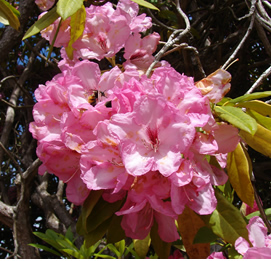Host Testing
Susceptibility, severity, and sporulation potential of Phytophthora ramorum on several Rhododendron species and hybrids
Marianne Elliott, Gary Chastagner, Katie Coats, Annie DeBauw, and Kathy Riley, Washington State University, Puyallup Research and Extension Center, 2606 W. Pioneer, Puyallup, WA 98371; melliott2@wsu.edu
Several plant genera are important in the spread of Phytophthora ramorum in nurseries. These include Rhododendron, Camellia, Viburnum, Pieris, and Kalmia. Very few studies have been done on these potentially important epidemiological hosts in nurseries. In an effort to reduce the risk of P. ramorum being introduced onto their sites, some nurseries have reduced or eliminated these species from their inventory.
Rhododendrons are an important nursery crop in the Pacific Northwest and have accounted for about 78% of the infected plants associated with positive nurseries in Washington since 2004. In an effort to identify the risk that certain Rhododendron species and hybrids pose in spreading this pathogen we have been examining the susceptibility and sporulation potential of P. ramorum on 42 Rhododendron species and 58 hybrids using an isolate of P. ramorum originally taken from Rhododendron. This isolate belongs to the NA1 lineage, which is the most commonly detected lineage of P. ramorum in Washington nurseries. Detached leaves were inoculated with a zoospore suspension on the upper and lower surfaces in both wounded and non-wounded treatments. Lesion area was measured after 5 and 10 days and production of sporangia and chlamydospores was assessed for each species and hybrid.
There was a great deal of variability among Rhododendron species and hybrids in their susceptibility to infection by P. ramorum, severity of symptoms, and production of sporangia and chlamydospores. Several species and hybrids could be considered resistant, with low incidence and severity of disease and low levels of sporulation. These would be good candidates for nursery production and possibly for future hybridizing material. Likewise, several species and hybrids that were very susceptible and supported high levels of sporulation were identified. In most cases lesions were larger on wounded than non-wounded leaves, and there was a higher infection frequency on the lower leaf surface than on the upper surface.
in
Proceedings of the Sudden Oak Death Fourth Science Symposium 2010
Susan J. Frankel, John T. Kliejunas, and Katharine M. Palmieri, tech. coords.
Gen. Tech. Rep. PSW-GTR-229. Albany, CA: U.S. Department of Agriculture, Forest Service, Pacific Southwest Research Station. 378 p
| abstract | poster |
Contact: Gary Chastagner, 253-445-4528 | WSU Puyallup Research & Extension Center, 2606 West Pioneer, Puyallup, WA, 98371-4998 USA
Last updated January 2, 2013
